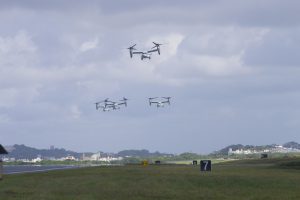Last week, Okinawa newspapers reported that the Japanese government had announced a new time schedule for the construction of the U.S. Marine Corps superbase at Henoko, in the northern part of Okinawa Island. The base is supposed to be the new home of the 1st Marine Air Wing, now dangerously housed at Futenma Airbase smack in the middle of Ginowan City, farther to the south.
The Okinawan people’s overwhelming opposition to the project, and the refusal of both the U.S.and Japanese governments to listen to that opposition, has dominated Okinawan politics for the last 30 years. For Japanese government officials, who have been declaring year after year that nothing on earth could stand in the way of this juggernaut construction project, admitting that there would be a delay must have been mortifying.
The way the delay was reported in the Ryukyu Shimpo, the paper I read, reflected this discomfort. The article began by saying that the five years projected for construction had been extended to 10 years. But then it went on to say that the target date – the date when the new facility was to be handed over to the Marines – had been moved from 2022 to 2032. It was left up to the readers to make the simple calculation that would yield the embarrassing number, 15.
The next day I took the charter bus from Naha to Henoko to join a sit-in that seeks to block the trucks carrying dirt with which to reclaim part of the bay there.
Standing just up the hill from the sit-in there was (as usual) an observer with the words “Prime Minister’s Office” printed on the back of his jacket. I struck up a conversation with him.
“I read that the projected construction time has been extended.”
“Oh yes”, he said, “the five years is now 10 years.”
“No, no, the target date has been moved back ten years. Five years plus 10 years makes 15 years.” After some confusion and fruitless fiddling with his smart phone, he acknowledged that I must be right.
Then I asked him if this new construction schedule was calculated taking the protest movement into account, or not. It took him some time to understand the question, but when he did, he said that the extension was made necessary because it was discovered that the sea bottom beneath the site is the consistency of mayonnaise, and whether or not the protest continues it will take that much time to firm it up.
I asked, “Don’t you think that whether the protest continues or not will make a difference in how much time it takes?”
The answer he gave can be translated, “That’s true too.”
This is the person dispatched by the Prime Minister’s office to observe the protest movement in Okinawa, presumably one of their Okinawa experts.
A couple of days later the government’s story changed again.
The newspaper headline stated that construction would take 12 years “from the date of the construction permit issued by the Prefectural Governor. People who read just the headline will assume that means the permit given by former Governor Nakaima in 2013, after four years of posing as an opponent of the base. But you need to read the fine print. With the discovery of the unstable sea bottom, the construction project for which Nakaima gave his permit became impossible. The Defense Bureau needs to come up with a different plan, which will require a new permit. The present governor, Tamaki Denny, was elected on an anti-base ticket and has sworn he will never grant a new permit. So it is entirely unclear when the Marines will get their superbase at Henoko – if in fact they ever do.
The AP version of this story, which was dated December 25 and appeared in the New York Times and other papers, seems to share the same reluctance to face the full boondoggled reality of this project. The headline announces that both the time and the cost of the relocation of Futenma Base have doubled. The first line of the article says it’s going to take “more than twice” the time. Well, OK, “three times as much” is definitely “more than twice as much,” but that’s a strange way to put it.
But then this is followed by the comment that the project “has already been delayed by more than 20 years because of local opposition and other reasons.”
That is accurate. But if so, where do these five year and 10 year figures come from? The Japanese government keeps shortening the project’s alleged time span by moving the starting line forward. The plan to move the Marines’ 1st Air Wing from Futenma Base to a new facility at Henoko was first announced in 1996. That was opposed by the overwhelming majority of the Okinawan people from the time it was announced, and a campaign of nonviolent civil disobedience was begun to prevent it from happening. This has included lawsuits, sit-ins, vigils, the election of an anti-base governor, demanding an accurate environmental assessment, and the formation of a flotilla of sea-kayaks actually to interfere with the Defense Agency’s attempts to survey the sea bottom on the site to be reclaimed for the new airstrip. It took the Defense Agency until 2013 to come up with a construction plan. Construction, they announced, would take five years, and be completed in 2022.
Now that goal has been updated to 2032 — 36 years (and counting) after the plan was first proposed.
C. Douglas Lummis is Coordinator of the Veterans For Peace, Ryukyu/Okinawa Chapter International (VFP-ROCK).

































